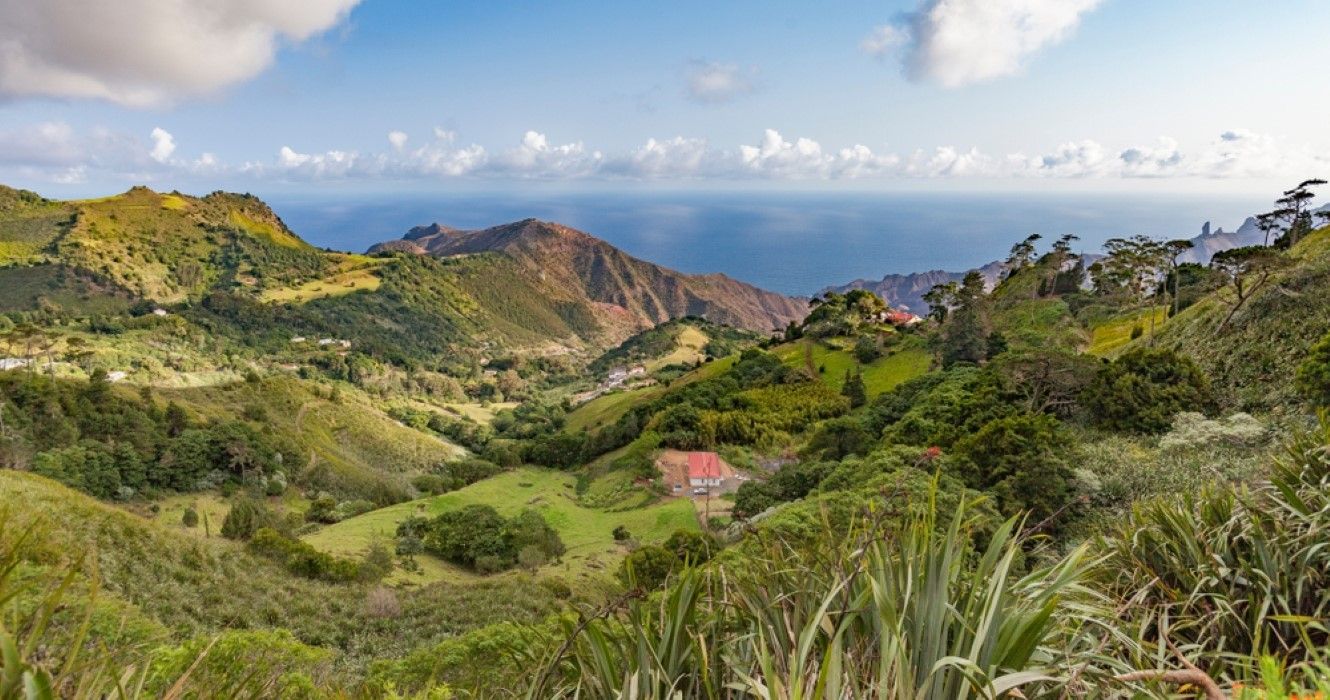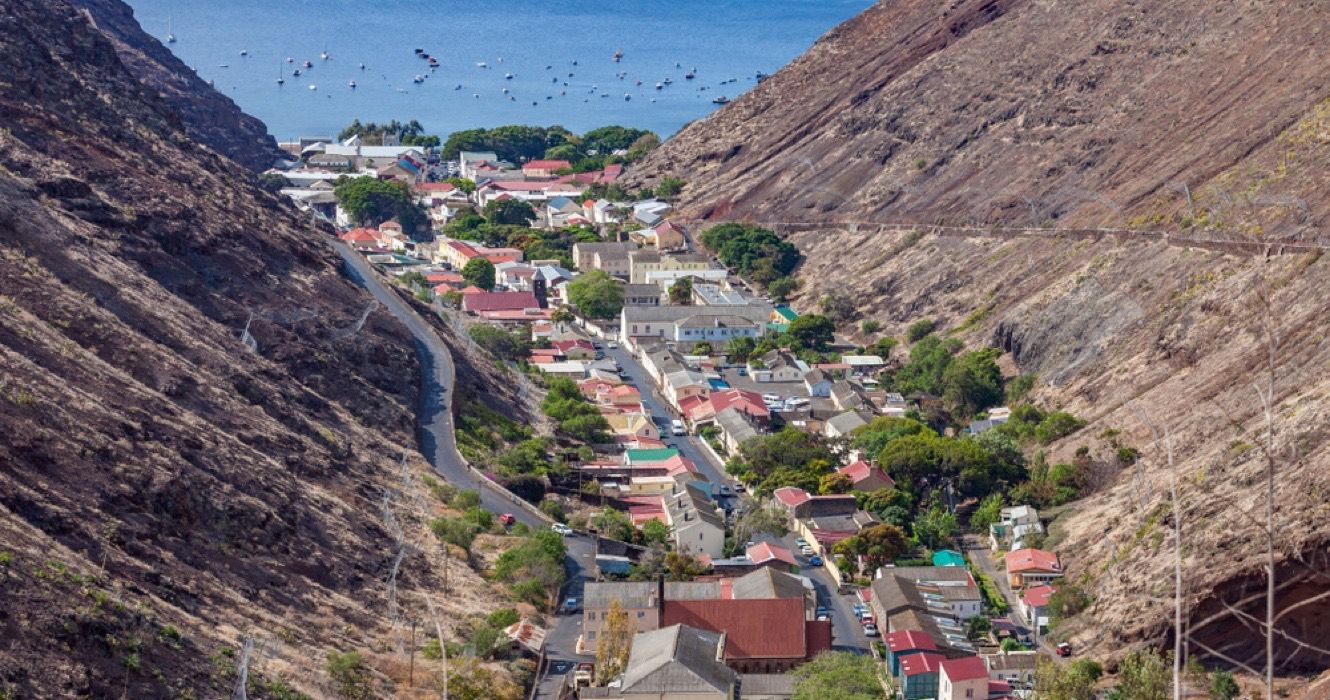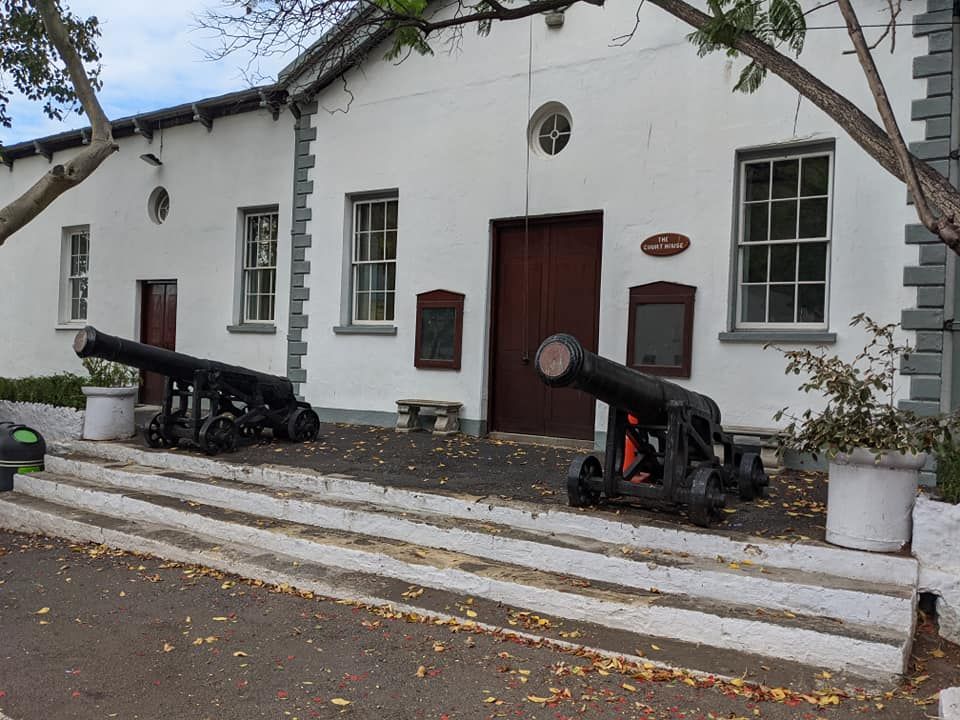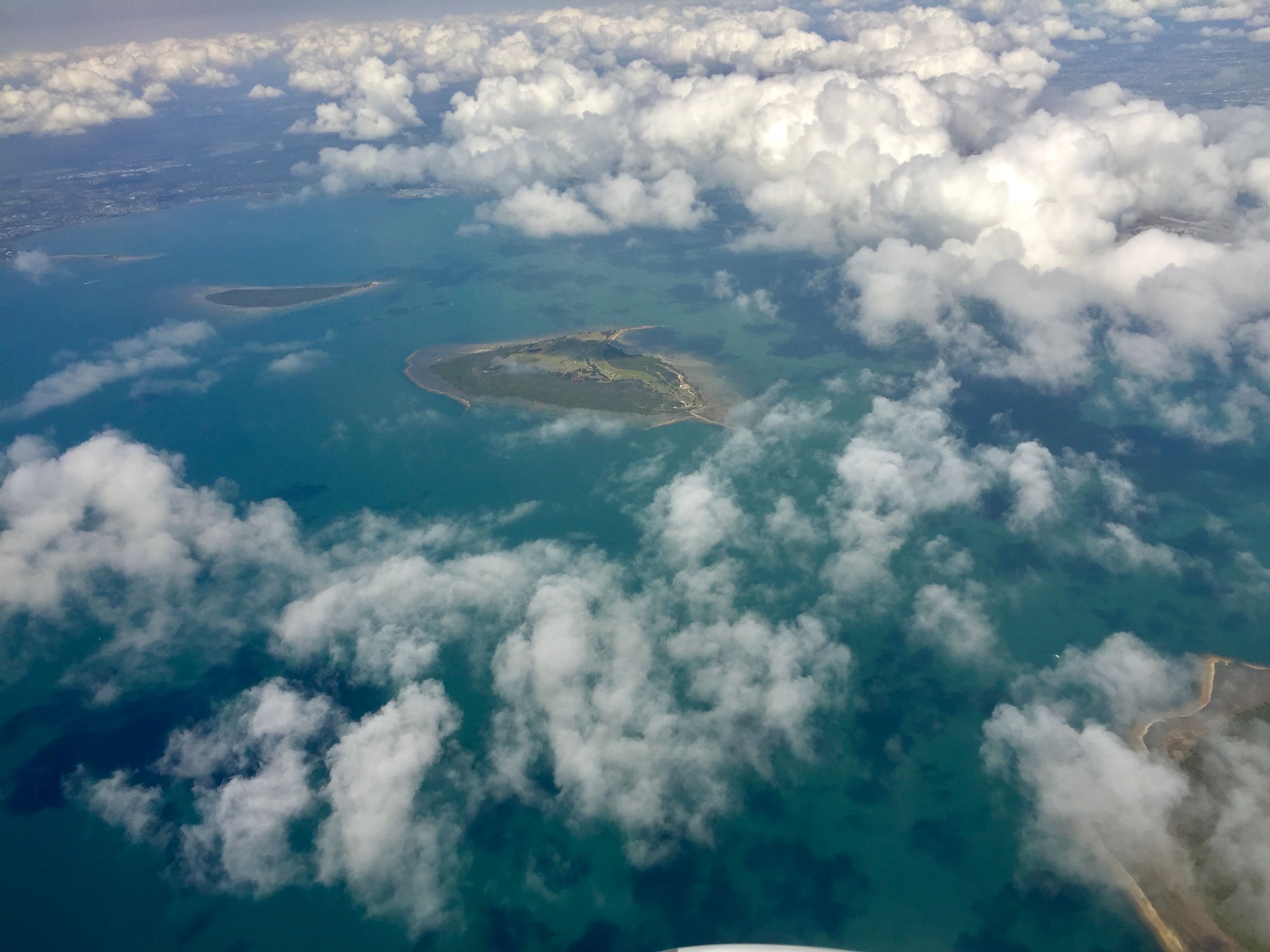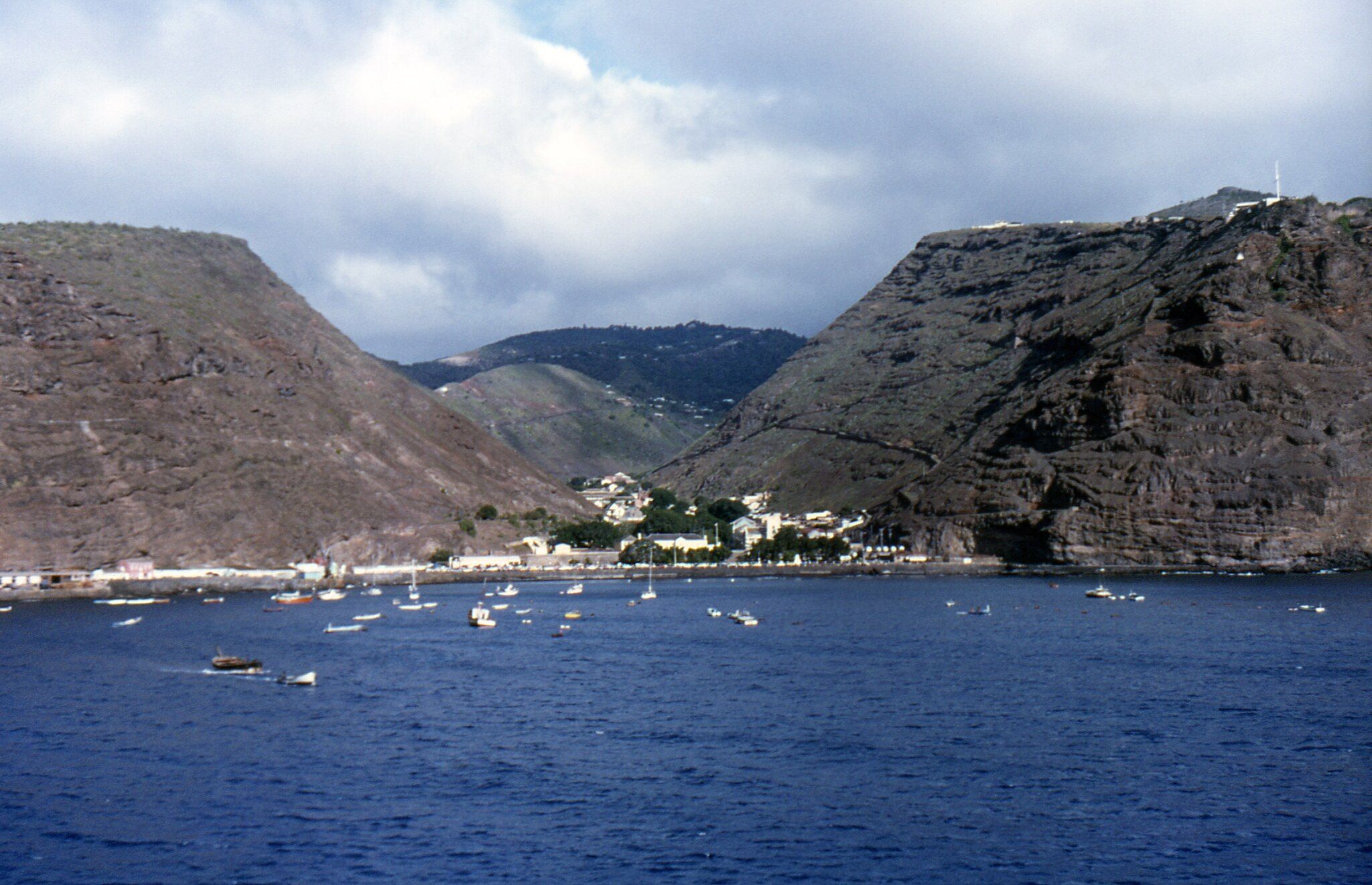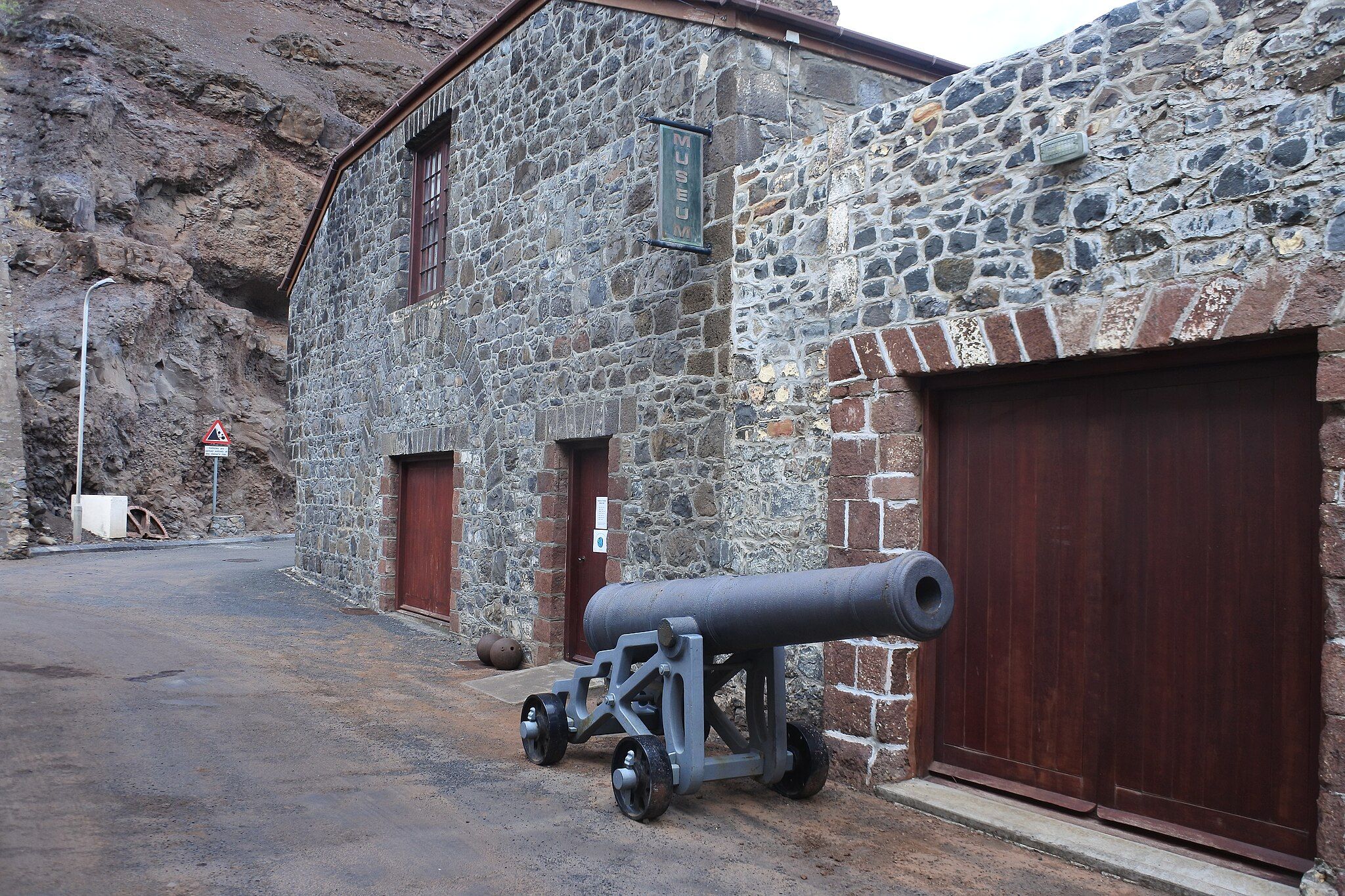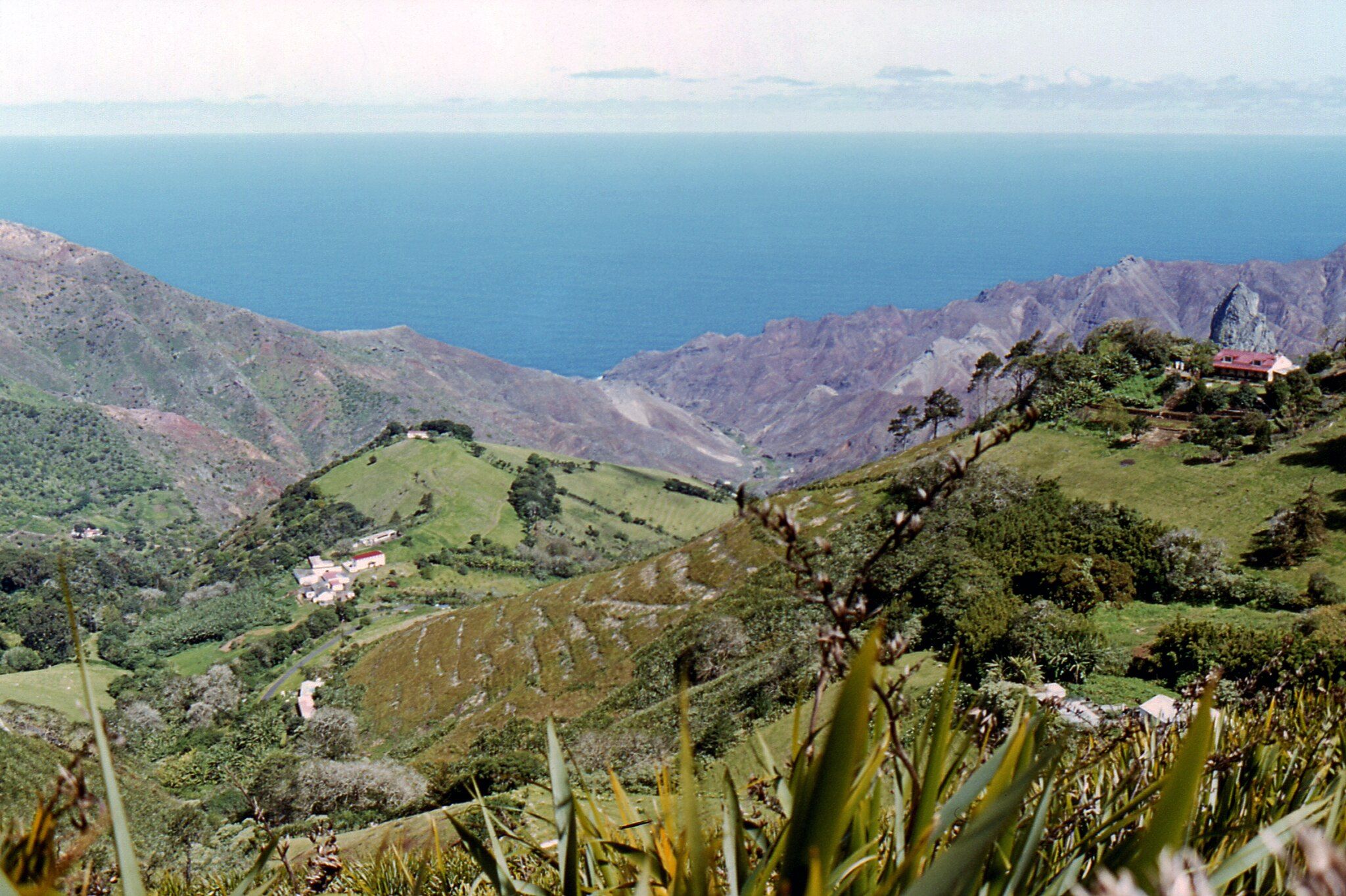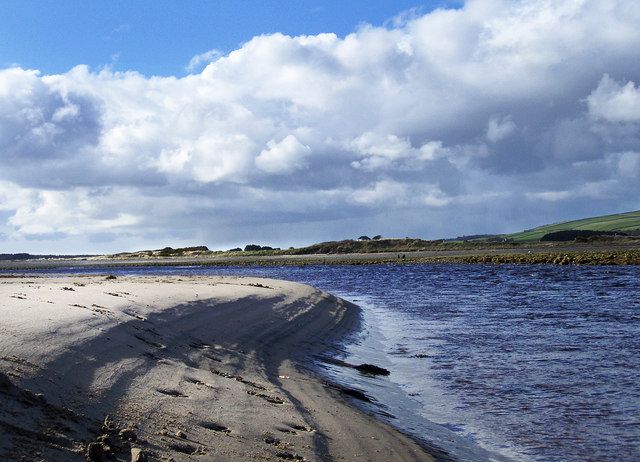Read update
- There's More To Know About St. Helena
Quick Links
Summary
- St. Helena, a small island in the South Atlantic, boasts a fascinating yet controversial history, making it a must-visit for history buffs and dark tourism enthusiasts.
- Despite its remote location, St. Helena offers beautiful landscapes, welcoming locals, and a range of activities such as scuba diving and exploring historic sites.
- The recent addition of an airport has made St. Helena more accessible, and travelers can enjoy a crowd-free retreat with stunning natural landscapes and a mix of charming towns and dark historical sites.
A relatively small subtropical island in the middle of the South Atlantic, St. Helena finds itself isolated from much of the world; the closest mainland, Africa's west coast, is some 1,200 miles from this tiny British Overseas territory - a speck on the map comprising Ascension Island to its north and Tristan Da Cunha to the south. Around ten miles of the island hosts a population of just over 4,500 residents, a people known as the Saints, whose reputation as some of the friendliest humans on the planet precedes itself and makes St. Helena all the more enticing to experience - but hospitable locals are not the sole reason to visit, of course.
Though famed for its astonishing natural beauty and British-meets-semi-tropical vibe, it's St. Helena's illustrious and even nefarious history is a standout sample of what makes the island all the more alluring. The place is a must for keen-eyed history buffs, perhaps even deserving a spot on the worldwide dark tourism trail, given its somber tales and harrowing happenings. Having been a British Overseas Territory for most of its volatile history, St. Helena was a frequented stopover point on the trade routes to the southeast, and, unfortunately, it did have a role in the transatlantic slave trade.

St. Helena Island - Where Napoleon Was Famously Exiled - Is Now Easier To Reach With Introduction Of New Flights
Reaching the island of St. Helena, which is situated in the middle of the South Atlantic, is now more accessible thanks to a new weekly flight.In spite of its fascinating yet questionably sketchy history, St. Helena remains a beautiful and welcoming place flourishing with surreal sights, amazing attractions, and bucket list-worthy activities. From scuba diving and whale shark spotting to hiking along the rugged volcanic coastline, the great outdoors abound on this petite island in the middle of the sea. Granted, though, some travelers prefer to stay dry and relaxed without too many physically taxing items on the vacation menu, which is why exploring the historic capital of Jamestown and all its museums or soaking up the lush green hilly island interiors do nicely for such folks.
The only element St. Helena needed to perfect itself as an accessible vacation destination was an airport - and that was taken care of in 2017 when its airport finally opened, offering direct flights to and from South Africa. While the island is still considerably remote and somewhat under-visited, undertaking the journey is absolutely worth it, particularly for those in search of a crowd-free retreat with a delightful mix of breathtaking natural landscapes, charming old towns, and dark history. Whatever the reason for a visit, planning ahead for the perfect trip is the key to making the most of St. Helena and everything it has to offer.
UPDATE: 2023/10/03 12:17 EST BY NOAH STAATS
There's More To Know About St. Helena
This article has been refreshed with new information regarding traveling to St. Helena Island and expanded points on existing facts. Even though it is remote and difficult to get to, this Atlantic island is certainly worth considering for your next vacation!
What Is St. Helena Known For? (A Brief History Of St. Helena)
- St. Helena was discovered in the early 1500s by the Portuguese.
- The island worked as a stopping ground between trade routes.
First discovered by the Portuguese in 1502, those stepping on its lands found a luscious island with a fertile inland of rich, dense forest - but lacking any indigenous populations. As a useful spot on their route on their travels to and from Asia and Southeast Africa, the Portuguese employed St Helena as a convenient stopover and a place to stock up on fruit to help fight scurvy - a potentially fatal ailment commonly affecting sailors at the time, which caused by a long-term lack of vitamin C.
The Portuguese even built a chapel in the valley, which is now where the capital of Jamestown is situated today - named after the Duke of York, who was later crowned King James II. Despite seemingly making themselves at home and getting to work with construction projects, they didn't exactly establish an official settlement per se; other than a few stranded sailors here and there and the odd person left on the island as punishment, it remained mostly uninhabited long time. Having said that, the Portuguese brought non-native species to the island, including pigs, chickens, and goats, for meat farming, which sounds harmless in essence - or so they thought.

10 Islands That Are So Remote They're Almost Impossible To Reach
With incredibly rough waters and locations that are nearly impossible to reach, it's a wonder these remote islands have even been discovered.The Portuguese seemingly had a penchant for the island for quite some time, but it wasn't until the end of the sixteenth century that the English thought, 'hmm, we like this place - we want a piece of its pie.' Doing what the English do best, their piqued interest in St. Helena led to conflict with the Portuguese; however, the latter did not wake up and choose violence that day.
In fact, the Portuguese hadn't even upheld any territorial claims on the island, never mind a military presence; hence, conceding and avoiding St. Helena for fear of battles with the English seemed like the best idea from their point of view. Eventually, after several other scuffles over the years - including a brief brush with the Dutch at one point in the timeline - the British East India Company swooped in. It took the island in the second half of the seventeenth century. However, one of the most iconic moments in its history had not yet come into apparition; that was still to come.

The Most Remote House In The World Sits On This Island, And Its Owner Is A Mystery
The most remote house in the world sits on this island, but it's not actually a house, and it's not as deserted as you think.What was quite possibly St. Helena's most monumental moment in its human-related history came with its most famous exile of all time in 1815 - Napoleon Bonaparte. The French military leader and emperor who conquered much of Europe was present on St. Helena from the date of his exile right up until his death in 1821, with himself and all his military guards bringing about an almighty boost to the local economy thanks to the hype surrounding his presence. Be that as it may, that economic height did decline after Napoleon's passing and his troops' withdrawal.
Fairly soon after the ex-emperor of France's demise, the East India Company's reign of St. Helena came to an end when it was bestowed the status of a Crown Colony in 1834, a transfer of rule which also changed the island's activities in the unfortunate sphere of slave trading. Though slavery saw its end in the British Empire in 1807, it wasn't properly abolished until 1834, several years after which the Royal Navy began actively hunting down other nations' illicit slave ships - the Portuguese being one of its main targets since it had already a begrudged bulls-eye placed on their backs from past frictions. What's more, almost 25,000 freed slaves were taken to St. Helena from 1840 until around the mid-1860s, many of them sadly on the brink of death upon gaining their freedom - which came too little too late for many.

You Can Visit Maison Bonaparte, The House Where Napoleon Was Born
The Maison Bonaparte is the ancestral home of the Bonaparte family and it is a museum open to the public today.For the most part, the survivors of slavery who found themselves on St. Helena were housed in Rupert's Bay. At the same time, those suffering from contagious diseases were contained in Lemon Valley, which was used as a quarantine station. It pains to say that out of the approximately 24,500 freed victims of slavery brought to St Helena, around 5,000 died there; however, many of the fortunate survivors moved on, whilst a few hundred stayed on the island and integrated into the community.
In more modern times, the atrocious events of the slave trade and the subsequent camps set up for freed slaves were almost forgotten about - until 2006. Expansive slave burial grounds were uncovered during the building of a new road intended to facilitate the transportation of materials to the island's planned airport construction, sparking an in-depth archeological survey as a result. Amazingly yet sadly, 350 bodies and numerous items were discovered and thus examined by experts. Today, The St. Helena Museum is home to many of the artifacts recovered from the burial sites, where they are on display for visitors to view, learn about, and appreciate what went on throughout the island's heinous history while paying respects to the people who suffered at the hands of slave traders all those years ago - which, on the grand scale of time, isn't all that long.

Tour Napoleon's Tomb & Learn The Military History Of France At Les Invalides
The Les Invalides is one of the most important museums and complexes in Paris and is home to Napoleon's tomb.Is St. Helena Worth Visiting?
- St. Helena is very beautiful and hosts many historical areas.
- The charming capital area is a tourist hot spot and will feature many places to eat, stay, and tour.
With a wealth of wonders to discover comprising pristine volcanically carved landscapes, verdant subtropical forests, a captivating marine world, and a historically charming capital with important historic sites, potential St. Helena tourists can decide for themselves if the island does indeed sound worth visiting in the following section. Hint: the answer is absolutely 'yes.'
Road Trips and Hiking In St. Helena
This picturesque remote island is undeniably worth every effort it takes to get there. Boasting a rugged volcanic coastline prime for exploration, it's an adventurer's playground, a photographer's dream, and a nature lover's fantasy. Driving or hiking along twisting and winding country roads past green fields and quaint churches makes it feel akin to the English countryside, yet the warm, inviting weather is anything but British.
21 postbox walks also open up experience-rich hiking escapades for walkers, each with varying intensity levels suited to all abilities. Those with a little more stamina will particularly enjoy the hike to the highest point on the island, Diana’s Peak, which is 823 meters above sea level - although not actually that taxing since the path is quite straightforward. On the other hand, fitter folks might favor following the path from Sandy Bay Beach, which sends walkers across the dramatic volcanic landscape to the tidal pools found at Lot’s Wife’s Ponds.
Visit Jamestown: Discover St. Helena's History And Listed Buildings
As for St. Helena's 'urban sprawl,' the capital ticks all the right boxes in terms of historic appeal and architectural charm, not to mention its significance as the place where Napoleon first stepped ashore, the timeless aura for which the island is loved is most prominent in Jamestown, where Georgian architecture and a characterful colonial atmosphere provide personality to its streets, throughout which more than half of St. Helena's listed buildings are dotted - many even having been built from the island's volcanic rock. Further bolstering its historic authenticity still evident today - as well as its deserved proposal as a UNESCO World Heritage Site - the Jamestown of present largely remains as the Jamestown was in the island's historic heyday, with an array of important buildings still intact as they were all those years ago.
From the Castle with its Union Jack flying high - the main government building dating as far back as 1659 - to the beautiful St. James Church - the oldest Anglican church in the entire Southern Hemisphere - stories of the past are visibly present in the nooks and crannies of the town's olden structures, which after viewing, soaking up the scenery at the waterfront's coffee shop is the ideal place to sit back and adore their marvel. There's also a coffee plantation for caffeine addicts to explore. However, if coffee's not strong enough, perhaps sampling local boozy beverages at the world's most remote distillery might do the trick.

Your Guide To The Tombs Of British Monarchy
British Monarchs are buried in Lonon and around England and one can visit most of their tombs today.Just a couple of miles south of the capital, another noteworthy itinerary item beckons: Plantation House, the official residence of the current governor of St. Helena, which dates back to 1791. After taking a tour of the stately colonial property, visitors even get to meet the island's oldest inhabitant, Jonathan, the adorable giant tortoise, who lives in the estate's garden and is believed to be the world's oldest living reptile at 190 years young (as of 2022), having first hatched in 1832.
Visit The Napoleonic Sites On St. Helena
Ultimately, whether acknowledged or not, the island's history is a St. Helena tourist's dangling carrot, and historic French conquerer Napoleon is the biggest bait in the bag. Having been exiled to the island and spending the final years of his life living on its lands, history enthusiasts from all corners of the globe descend to visit the many Napoleonic sites connected to his presence - including the place he called home after his eventful days as the emperor of France.
Visitors can visit Longwood House, Napoleon's primary residence on the island, which now serves as a museum maintained by the French. Furthermore, history lovers can check out the Briars Pavilion or enjoy a stroll through the tranquil Sane Valley to discover the very spot where Napoleon's tomb once lay until it was removed and taken to France in 1840.
Snorkeling And Scuba Diving In St. Helena
Of course, the sea around St. Helena gets an equal shout-out; the crystal-clear waters bustle with marine life, with possible sightings including dolphins, humpback whales, and even the biggest fish in the ocean: the gargantuan whale shark. These enormous spotted creatures visit the warm coastal waters between November and March, and stringent regulations are in place to ensure these gentle giants remain protected while divers and snorkelers enjoy being in their majestic presence.

Where To Dive With The Ocean's Biggest Fish: The Majestic Whale Shark
The largest fish in the sea is as elusive as it is colossal. But there are a handful of locations where one can meet this magnificent gentle giantTo the north of the island, the protected waters provide excellent swimming and scuba diving conditions all year round, where sheer rocky walls rise up from the dark depths to create surreal sub-seascapes housing myriads of underwater creatures. Plus, as a result of the island's long maritime history, divers can also explore a number of wrecks around St. Helena, some right outside the capital in James Bay. One such local favorite shipwreck is the SS Papanui, which burnt out and sank to the bottom of the bay in 1911 and is partially visible from land during low tide. Snorkelers can get in on the wreck action, too; simply snorkeling over the sunken vessel grants a decent view - but if that's not good enough, Jamestown offers dive centers that can turn snorkelers into scuba divers.
Overall, thanks to its diverse underwater realm, incredible marine species encounters, and fantastic ocean conditions, St. Helena's popularity as a dive destination is increasing exponentially, with divers worldwide cherishing the island and its spectacular dive sites as a very special hidden gem.
When To Visit St. Helena
- The best time to visit St. Helena Island is year-round.
- November through March is when most tourists come here.
St. Helena Island is a sublime year-round vacation destination boasting average temperatures of 20 °C to 27 °C. Much to sweaty visitors' delight, trade winds cool the island during summer, preventing the atmosphere from being too hot and sticky. The warmest and thus busiest tourist season runs from November through March, throughout which the skies are sunny, and the air is hot. This time is also the best for spotting whale sharks in and around the island's inviting waters, with January offering the highest chances of seeing these enormous fish.
Visitors arriving in the winter between July and October are met with cooler temperatures and more rain - how very British. However, downpours are more than made up for by the season's humpback whales, who visit St. Helena from July to December every year.

These British Castles Have Us Feeling Ready For Spookier Seasons (And Are Open For Tours)
Castles are mesmerizing, enchanting, and altogether fascinating, and these come with a history that's just as eerie as it is intriguing.The Southern Corner Of St. Helena Doesn't Require A Guide
- Visitors should be free to check out the southern tip of St. Helena without a guide.
- Private planes can fly into the island's airport.
One other thing to be aware of when traveling to St. Helena Island is that sections of the island are closed to the public and require a dedicated tour guide. Typically, the southern end of the island is where visitors can come to roam and stay freely without a guide, so that is where we recommend going. It is also important to note that this island is very tiny and very remote. Many tourists don't realize how off the grid St. Helena is, becoming a bit anxious once on land.
Commercial flights come to and from St. Helena periodically, but there won't be an endless roster of choices. There may only be 2–3 flights in and out of the island on a given week. According to the official tourist website for St. Helena, people can charter their own planes to and from the island's airport, so that is another option. Those with their own plane should be able to obtain ground clearance and begin their vacation.
This tiny island is close to Africa and Australia, making either continent a great starting point. The best idea is to reach out to a tour guide or vacation planner in the area and work with them on an itinerary for the trip. From August 2022, St. Helena lifted its COVID-19 entry regulations, meaning guests no longer have to self-quarantine upon arriving. That makes this process a little more streamlined and comfortable for everyone.
There are countless cheap islands to visit across the world. Make sure and book flights in advance and follow all local rules and protocols.
Important Things To Know Before Visiting St. Helena
As paradisiacal as the island is, travelers mustn't let their excitement get ahead of them. Instead of booking that dream getaway and jet-setting off without prior plans, making sure to brush up on these top travel tips will help St. Helena's visitors get the most out of their trip, as well as minimize the risk of unexpected mishaps:
- Book in advance: this is a tiny island with a limited tourist capacity. As a result, St. Helena-bound guests must book flights, car rentals, accommodations, tours, snorkeling trips, and scuba diving programs and excursions well ahead of their arrival.
- Take plenty of cash: the island has no ATMs. The only way to get St Helena pounds or pounds sterling in cash is at the bank in the airport or in Jamestown using a debit card during their opening hours.
- Pack appropriately: sunscreen, sunglasses, and wide-brim hats are essential for sun protection. Also, a waterproof jacket wouldn't go amiss when exploring the cooler, higher-elevation parts of the island.
- Get travel insurance: it's mandatory to have travel insurance with medical evacuation coverage when traveling to St. Helena. Arrivals will be asked to show proof of insurance at the airport, so it's important to have a copy of any policies out and ready in order to breeze through official checks. In addition, flights can easily be postponed by over a day; therefore, having comprehensive insurance that covers potential delays is wise, as is proper planning when booking connecting flights and being sure to allow ample time between connections.

Fruit Fool, Banoffee Pie, And Every Other Delicious British Dessert That's Not Pudding
The U.K. might be known for its pudding but these desserts have a far sweeter reputation than that.In a place of stunning landscapes perfect for hikes, mind-blowing snorkeling, and scuba diving experiences, charming colonial town life, and fascinating Napoleonic sites to tickle the fancies of discerning history geeks, St. Helena is an all-around paradise suited to every kind of traveler of any age and budget. It has to be said that the remarkable history and dark times of slavery don't particularly cast a solemn shadow on the island. Still, they have become something to respectfully discover and reflect upon through exploring compelling museums and heritage sites.
Guaranteed, visitors of this little island with a big place in history can truly enjoy the trip of a lifetime savoring everything it has on offer, so long as they are well-informed and plan ahead. Whether a trip to this glorious little land in the midst of the sea is looming on the ever-nearing horizon or is merely a fleeting idea, for now, keep this guide handy when planning that dream vacation to St. Helena - one of the most remote, mesmerizingly beautiful, and wholeheartedly interesting dots on Planet Earth.

